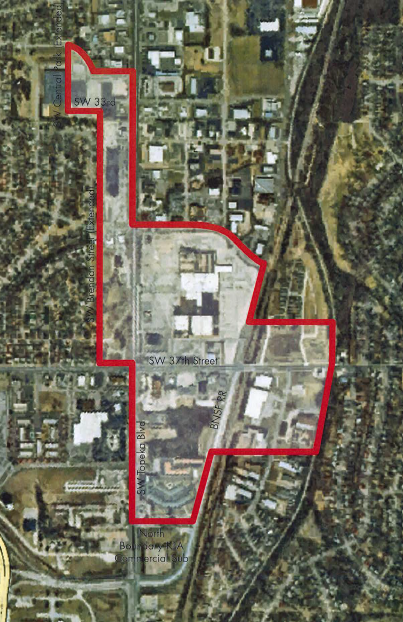Topeka leaders may create fifth TIF district to spur development at former site of White Lakes Mall
Though they felt sad, Topekans shared fond memories in December 2020 after an intentionally set fire significantly damaged the White Lakes Mall at 3600 S.W. Topeka Blvd.
Judy Moler-Steves recalled having had her ears pierced at age 21 in 1982 at a business in that mall called The Hat Box.
The pain from that experience left Moler-Steves thinking her husband should take her home afterward, because she wasn't sure she could drive effectively, she wrote on the Topeka History Geeks Facebook page.
Area is 'fairly blighted,' chamber president says
Though White Lakes Mall was torn down in recent months, Topeka's city government has "a chance to create new memories" in the area where it stood, City Councilman Brett Kell said earlier this month.
Kell, whose council district includes the former mall property, voiced support for the Greater Topeka Chamber of Commerce's request that the city establish a "South Topeka Redevelopment District" to allow for the use of tax-increment financing to encourage economic development in a specific area that includes the former mall property.
The TIF District's establishment would help bring important, positive change to what has been a "fairly blighted area," said Curtis Sneden, the chamber's president.
The mayor and council plan to discuss and consider approving that proposal Oct. 11.
More:'Bring Back the Boulevard' group plans major improvements along S.W. Topeka Boulevard
TIF districts may be created in blighted, aging or underperforming areas

The TIF district would include all property between S. Kansas Avenue, S.W. Topeka Boulevard, S.W. Croix and S.W. 37th streets, and some property to the east, south, west and northwest of that area.
The request for establishment of the TIF district was made after a developer expressed interest in developing the former White Lakes Mall property there, then-interim city manager Bill Cochran told the mayor and council.
The developer's identity hasn't been made public.
Interest has also been expressed in developing other properties that are part of the proposed TIF district, Sneden said.
Why establish TIF districts?
The general purpose of a TIF district is to help a development project happen where it otherwise wouldn't have,
TIF districts may be established in blighted areas, as well as aging or underperforming areas that aren’t blighted. Kansas law also allows for additional approaches.
Once a TIF district is created, developers may submit plans for projects in the area involved to be considered for TIF financing.
Resident thought she would lose her home
The mayor and council heard testimony at a Sept. 13 public hearing from a woman who said a map the chamber initially put forth indicated the house where she and her husband have lived for 47 years at 904 S.W. 37th was part of the proposed South Topeka TIF District.
She voiced concern that the TIF district's establishment would result in the house being taken away.
She learned her home was no longer part of the proposed district, according to a revised map that was put out more recently, and that the chamber had never intended for developers or the city to be able to take away anyone's properties there.
No homes are part of the proposed district, according to the new map. It was drawn in an effort to improve upon the earlier map by removing properties for which no interest in development had been expressed.
More:City TIF districts 'an important tool'
How do TIF Districts work?
Kansas law allows government entities to create TIF districts at the request of developers to help offset development costs.
Here is how that works.
Officials determine how much property tax and sales tax revenue the property generated before the project.
Then, after the project begins, they determine how much property tax and sales tax revenue the property generates each year. The increase goes to pay off eligible types of development costs.
For example, if the city collected $100 annually in tax revenue before a TIF district was formed and $500 annually afterward, the $400 increase would go to help pay development costs.
Developers pay off costs over a period of up to 20 years.
More:Mayor, council create downtown TIF District
How many TIF districts does Topeka have?
The city has four existing TIF districts.
Gretchen Spiker, the city's communications director, identified those as the following:
• Downtown Topeka's Dynamic Core Redevelopment District, bounded generally by S.W. Topeka Boulevard, S.W. 17th Street, S.E. Adams Street and the Kansas River.
• The Wheatfield Village TIF District, at the northwest corner of S.W. 29th and Fairlawn Road.
• The Sherwood Crossing TIF District, in the former Village West Shopping Center location at the northwest corner of S.W. 29th and Wanamaker Road.
• And the College Hill TIF District, located generally to the north of S.W. 17th and Washburn Avenue.
The College Hill district was formed in 2006 and hasn't done as well as city officials had hoped it would.
More:'South Topeka Boulevard didn't get the attention that it needed': Millions may change that
How costly was the College Hill project for the city?
Topeka taxpayers have been responsible for covering $3,480,588 of the costs involved with the College Hill project that couldn't be paid using revenue from the project, according to figures Spiker provided The Capital-Journal.
Those numbers indicate tax collections from the district so far have totaled $2,889,412, compared to a total debt service over that period of about $6,370,000.
More:This Topeka retail center sits almost vacant. Here's what the owners are planning for the area
The city responded to its experience with the College Hill TIF District by putting in place a TIF policy that prohibits the city from entering into any TIF arrangements in which it might incur financial risk.
Tim Hrenchir can be reached at (785) 213-5934 or threnchir@gannett.com.
This article originally appeared on Topeka Capital-Journal: Topeka eyes TIF district to spur development at ex-White Lakes Mall
